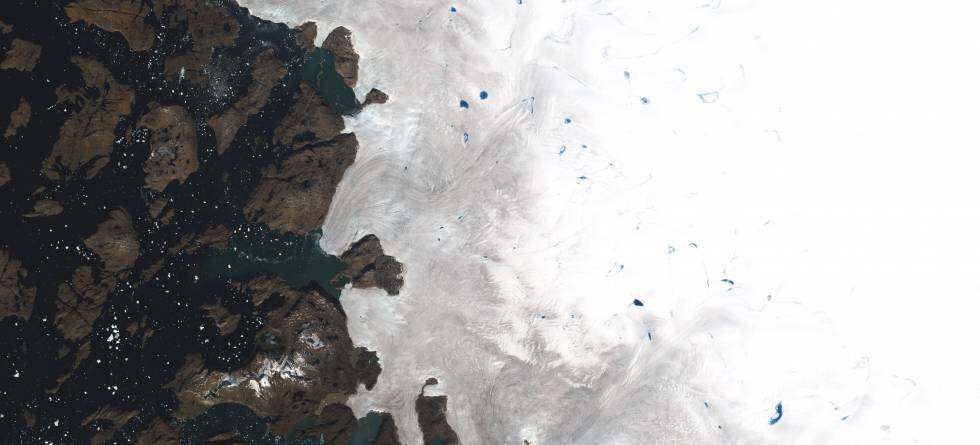Written by Nil Irvalı, researcher at the Bjerknes Centre and the Department of Earth Science at the University of Bergen
The Greenland Ice Sheet has been losing mass at an accelerating rate over the recent decades, and if melted completely, it will contribute up to 7.2 m of global sea level rise. Model simulations suggests a warming threshold for an ice-free Greenland to be in the range of 0.8–3.2°C (with a best estimate of 1.6°C), above pre-industrial era (e.g., Robinson et al., 2012 Nature Climate Change).
Recently, fears have grown that continued climate change will make the Greenland Ice Sheet (GIS) cross a threshold where long-term melting of the ice sheet is inevitable. Greenland's climate past and present could presage our climate future, hence understanding the past response of the GIS during intervals when conditions were warmer than present will help us to determine how future warming will impact this ice sheet.
A closer look at the ice age history of Greenland
However not much is known about the duration and magnitude of warming near Greenland in the past and climate records reconstructing past interglacials are sparse and often at low resolution. In a new study published in Proceedings of the National Academy of Sciences (PNAS), Nil Irvalı and co-authors took a closer look at the ice age history of Greenland and found that during past interglacials, both the magnitude and the duration of warming above a certain threshold is critical for GIS survival.
The Bjerknes-based and US scientist involved in this study used sediment samples from the International Ocean Discovery Program (IODP) coring site on the Eirik sediment drift off southern Greenland to unravel the past. The Eirik drift is produced by bottom currents and accumulates rapidly as a result of the influx of sediments eroded from the Denmark Strait and eastern Greenland margin suspended in Denmark Strait Overflow Water (DSOW).
The core site is located at the northern edge of the Subpolar Gyre (SPG), which dominates the surface water hydrography of the northern North Atlantic.
Previous studies at the core site (Kleiven et al., 2008; Galaasen et al., 2014) demonstrate that this location is sensitively situated to monitor subpolar climate near and partially over Greenland, fluctuations in GIS extent, and iceberg calving events. It also has the temporal fidelity to detect decadal-millennial climate-ocean variability.

May be less stable than previously thought
The team used calcareous marine microfossil shells to generate multiple temperature proxies reconstructing sea surface temperatures (SSTs) during four interglacial periods, spanning the past 450,000 years.
Changes in climate are portrayed using planktonic foraminiferal δ18O, foraminiferal assemblage counts, modern analog technique (MAT)-derived SSTs, and Mg/Ca paleothermometry using Neogloboquadrina pachyderma (sinistral) and Neogloboquadrina incompta. Ice-rafted debris (IRD) counts and planktonic foraminifer Ba/Ca are further used to infer iceberg supply and melt water input.
They found that SSTs were as warm or warmer than at present during all 4 previous interglacials, with mean summer SSTs ranging from 7–11 °C, compared with the modern value of 7.7 °C.
Our geological evidence and new climate model simulations agree with the temperature ranges estimated from previous modeling studies, but using an empirical approach (proxy reconstructions) we suggest for the first time that the duration above the lower limit of these ranges (0.8°C) might have been the one that was critical for explaining the near complete deglaciation of the southern GIS in the past.
The Greenland ice sheet may be less stable than previously thought
Our findings suggest that a near complete melting of the southern GIS ~400,000 years ago occurred under temperatures only slightly warmer than present (~0.5 (±1.6)°C) – within the range of projections for this century. Our results suggest that the duration of warming above a threshold was as important as the magnitude, and, if even modestly warmer conditions were sustained long enough GIS decline may already be unavoidable.
The study is part of the Research Council of Norway THRESHOLDS project, led by Prof. Ulysses Ninnemann.
Reference
Nil Irvalı, Eirik V. Galaasen, Ulysses S. Ninnemann, Yair Rosenthal, Andreas Born, and Helga (Kikki) F. Kleiven. A low climate threshold for south Greenland Ice Sheet demise during the Late Pleistocene, PNAS January 7, 2020 117 (1) 190-195.

